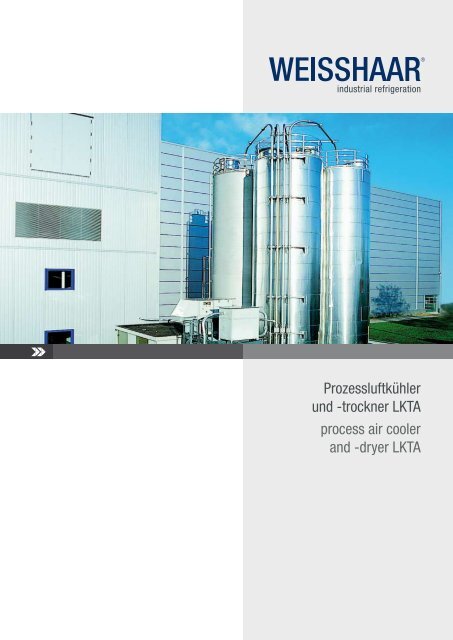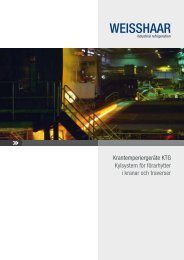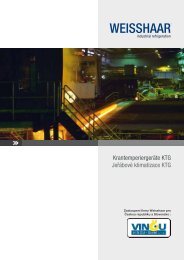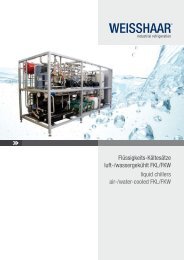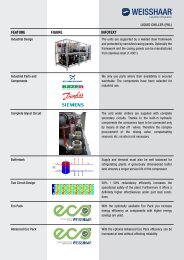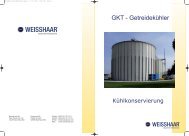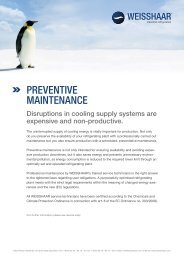dryer LKTA - Weisshaar GmbH & Co. KG
dryer LKTA - Weisshaar GmbH & Co. KG
dryer LKTA - Weisshaar GmbH & Co. KG
Sie wollen auch ein ePaper? Erhöhen Sie die Reichweite Ihrer Titel.
YUMPU macht aus Druck-PDFs automatisch weboptimierte ePaper, die Google liebt.
Prozessluftkühler<br />
und -trockner <strong>LKTA</strong><br />
process air cooler<br />
and -<strong>dryer</strong> <strong>LKTA</strong>
Wir sind ein mittelständisches Unternehmen und<br />
seit über 30 Jahren Ihr Partner bei speziellen<br />
kältetechnischen Problemstellungen.<br />
WEISSHAAR Prozessluftkühler und –trockner<br />
werden vielfältig in der Verfahrens- und Lebensmittelindustrie<br />
eingesetzt. WEISSHAAR beliefert<br />
heute führende Hersteller in der Lebensmitteltechnik.<br />
Vor Ort Schulung<br />
In site schooling<br />
INHALT<br />
WEISSHAAR Schulungszentrum<br />
WEISSHAAR Schooling Centre<br />
Pneumatische Förderung<br />
Vermahlung 3<br />
Prozessluftkonditionierung<br />
Gaswäscher & Gasreinigung<br />
Allgemeine Hinweise 4<br />
Physikalische Grundlagen 5<br />
Prozessluftwärmeaustauscher 7<br />
Kompaktanlage 8<br />
Prozessluftkühler/-trockner (<strong>LKTA</strong>) 9<br />
Vorkühlung 0<br />
Restwärmeabfuhr<br />
Zentrale Kälteerzeugung<br />
Integralsystem IS<br />
Planungsdaten 3<br />
Lieferprogramm 5<br />
We are a medium-sized company and for over<br />
30 years we have been your partner to find<br />
answers to special technical refrigeration<br />
questions. WEISSHAAR Process air -coolers<br />
and -<strong>dryer</strong>s are widely used in the Process-<br />
and Food related industry. WEISSHAAR is OEM<br />
supplier for the major manufacturers in the food<br />
process industry.<br />
CONTENT<br />
Service Schulung<br />
Service schooling<br />
Pneumatic conveyance<br />
Milling 3<br />
Process air conditioning<br />
Gas washer & gas cleaning<br />
General remarks 4<br />
Physical principles 5<br />
Process air heat exchanger 7<br />
<strong>Co</strong>mpact unit 8<br />
Process air cooler/-<strong>dryer</strong> (<strong>LKTA</strong>) 9<br />
Precooling 0<br />
Residual heat extraction<br />
Central chiller<br />
Integral system IS<br />
Checklist 4<br />
Delivery range 5
PNEUMATISCHE FÖRDERUNG<br />
Pulverige Stoffe werden heute in der chemischen,<br />
kunststoffverarbeitenden und insbesondere in<br />
der Lebensmittelindustrie sehr effizient pneumatisch<br />
gefördert. Um die Förderfähigkeit zu<br />
ermöglichen und hygienischen Ansprüchen zu<br />
genügen, verlangen hygroskopische Medien<br />
wie Puderzucker, Molkepulver, aber auch Mehlstärke,<br />
Kunststoffgranulat und verschiedene<br />
chemische Stoffe einen abgesenkten Taupunkt<br />
der Förderluft. Trockene Förderluft ist zwingend<br />
notwendig in Gebieten hoher Luftfeuchtigkeit,<br />
wie in großen Teilen Asiens das ganze Jahr über<br />
vorherrschend. Viele Stoffe benötigen neben einer<br />
trockenen Förderluft eine abgesenkte bzw.<br />
moderate Fördertemperatur, wie z.B. der Zucker,<br />
der bei höheren Temperaturen karamellisieren<br />
würde.<br />
In der pneumatischen Förderung finden üblicherweise<br />
Drehkolbengebläse, Seitenkanalverdichter<br />
oder auch Schraubenverdichter Anwendung.<br />
Bezogen auf das Gebläse finden WEISSHAAR-<br />
Prozessluftkühler und –trockner der Serie <strong>LKTA</strong><br />
hierbei sowohl saugseitig, als auch druckseitig<br />
ihre Anwendung. Über 30 Jahre Erfahrung lassen<br />
uns für Sie die wirtschaftlich und technisch optimale<br />
Lösung finden.<br />
VERMAHLUNG<br />
Bei der Vermahlung von z.B. Puderzucker, Gewürzen,<br />
Kakao und ähnlichen Lebensmitteln geht<br />
es weniger um die Absenkung der Feuchtigkeit,<br />
als vielmehr um den Abtransport überschüssiger<br />
Mahlwärme. Gerade unter inerten Bedingungen<br />
finden Geräte der Serie <strong>LKTA</strong> eine breite Anwendungspalette.<br />
Auch können modifizierte Geräte zur Luftbefeuchtung<br />
eingesetzt werden, welche Anwendung<br />
in der Puderzuckerkonditionierung finden.<br />
PNEUMATIC CONVEYANCE<br />
Today powdery substances are pneumatically<br />
conveyed in a very efficient way in the chemical<br />
and plastic processing industry, and in particular<br />
in the food industry. For hygroscopic media, such<br />
as icing sugar, whey powder, but also for flour<br />
starch, plastic pellets and some other chemical<br />
substances, the dew point of the conveying air is<br />
to be reduced to make conveyance possible and<br />
to meet the hygienic requirements. In areas with<br />
a high humidity, such as in large parts of Asia<br />
where this rate is high throughout the whole year,<br />
dry air is absolutely necessary for conveyance.<br />
Many substances, such as sugar that would caramelise<br />
at higher temperatures, need low and/<br />
or moderate conveyance temperatures beside<br />
dry conveyance air.<br />
Rotary piston blowers, or screw-type compressors<br />
are used in the pneumatic conveyance<br />
field.<br />
For blowers WEISSHAAR-process air coolers<br />
and <strong>dryer</strong>s of the <strong>LKTA</strong> series are used not only<br />
on the pressure but also on the suction side.<br />
Thanks to our more than 30-year experience we<br />
can find the optimal solution for you from the<br />
economic and technical point of view.<br />
MILLING<br />
When icing sugar, spices, cocoa and similar<br />
foodstuffs are to be milled it is rather important<br />
to extract the excess heat generated during the<br />
milling process than to reduce humidity. The<br />
units of the <strong>LKTA</strong> series are used in many fields,<br />
above all under inert conditions.<br />
It is also possible to use modified units for air<br />
humidification, e.g. for icing sugar conditioning.<br />
3
PROZESSLUFTKONDITIONIERUNG<br />
Führende Hersteller im Lebensmittelbereich greifen<br />
auf unsere langjährigen Erfahrungen in der<br />
Prozessluftkonditionierung zurück. So wird in<br />
unserem Hause eine Vielzahl von herstellerspezifischen<br />
Geräten konstruiert und im Namen unserer<br />
Kunden gefertigt. Unser KnowHow nutzen<br />
dabei Firmen, die den Bereich der Kältetechnik<br />
an den Spezialisten auslagern möchten und dennoch<br />
ihren eigenen Kunden eine umfangreiche<br />
Produktpalette anbieten wollen.<br />
GASWÄSCHER & GASREINIGUNG<br />
Durch Taupunktunterschreitung fällt nicht nur die<br />
Feuchtigkeit der Luft aus, sondern auch in gewissen<br />
Anwendungen unerwünschte Nebenprodukte<br />
der Luft / des Gases. Diese, als Kältefalle<br />
bzw. Gaswäscher bekannte Verfahrensweise<br />
wird in vielen prozesstechnischen Anwendungen<br />
benutzt und lässt sich mit unserer Technik verwirklichen.<br />
ALLGEMEINE HINWEISE<br />
Allen Geräten gemeinsam ist die speziell entwickelte<br />
und patentierte Wärmetauscherbauform,<br />
die einen stark reduzierten Druckverlust<br />
auf der Prozessluftseite gewährleistet. Eine hygienische<br />
Tropfwasserabfuhr und -entsorgung<br />
ist gegeben, darüber hinaus lässt sich für verschiedene<br />
Anwendungen eine angepasste Reinigungsmöglichkeit<br />
verwirklichen.<br />
Die nicht benötigte bzw.<br />
abzuführende Wärme wird<br />
an die Außen- bzw. Umgebungsluft<br />
oder an vorhandenes Kühlwasser<br />
abgegeben. In vielen Fällen kann die<br />
abzugebene Wärme auch für andere Zwecke zusätzlich<br />
nutzbar gemacht werden. Wird eine Absenkung<br />
der relativen Feuchtigkeit notwendig,<br />
so verwenden die Geräte der Serie <strong>LKTA</strong> eine<br />
rekuperative Nacherwärmung, die nutzbringend<br />
einen Teil der Abwärme wieder verwendet.<br />
4<br />
PROCESS AIR CONDITIONING<br />
GAS WASHERS & GAS CLEANING<br />
WEISSHAAR Gaswäscher WEISSHAAR gas washer<br />
WEISSHAAR<br />
Wärmetauscher für Prozessluft<br />
Leading manufacturers in the food industry fall<br />
back on our many years’ experience in process<br />
air conditioning. Many customised units are<br />
being designed in our company and manufactured<br />
on our customers’ behalf. Our know-how<br />
is appreciated by companies who prefer to outsource<br />
the refrigeration engineering sector to<br />
specialists but simultaneously want to offer their<br />
own customers a wide range of products.<br />
Not only humidity is extracted from the air, but<br />
also undesired by-products are extracted from<br />
the air /gas when the temperature falls below<br />
the dew point. This procedural method known<br />
as cold trap and/or gas washer is used in many<br />
procedural applications and can be realised with<br />
our technology.<br />
GENERAL REMARKS<br />
The especially developed and patented heat exchanger<br />
design which ensures a significantly reduced<br />
pressure loss on the process air side is a<br />
common feature of all units. A hygienic drip water<br />
drainage and disposal is part of this design,<br />
and beside this an adapted cleaning unit can be<br />
realised.<br />
WEISSHAAR<br />
Heatexchangers for process air<br />
The heat which is not needed<br />
an/or is to be extracted<br />
can be transferred to the<br />
outside or ambient air or to any<br />
existing cooling water. In many cases<br />
the heat to be extracted can additionally be used<br />
for other purposes. If the relative humidity rate is<br />
to be reduced the units of the <strong>LKTA</strong> series use a<br />
recuperative reheating system to recycle part of<br />
the waste heat.
PHYSIKALISCHE GRUNDLAGEN<br />
Die Geräte der Baureihe <strong>LKTA</strong> machen sich das<br />
Prinzip der Taupunktabsenkung zur Entfeuchtung<br />
zu Nutze. Luft, die einen bestimmten Beladungszustand<br />
mit Wasser bei einer gegebenen<br />
Temperatur aufweist, wird zunächst an einer<br />
kalten Oberfläche abgekühlt bis die Luftfeuchtigkeit<br />
den Sättigungsbereich erreicht und in Form<br />
von feinen Tröpfchen ausfällt, man spricht von<br />
dem gesättigten Zustand .<br />
Eine weitere Abkühlung dieser Luft verschiebt diesen<br />
sogenannten Taupunkt, so dass der absolute<br />
Luftfeuchtigkeitsgehalt (gemessen in g/kg) weiter<br />
absinkt 3 . Die betrachtete Luft behält während<br />
dieser weiteren Abkühlung jedoch eine Luftfeuchtigkeit<br />
von 00 %, bleibt also gesättigt. Erst eine<br />
nachfolgende Aufheizung verringert die relative<br />
Luftfeuchtigkeit. Würde diese Luft nun wieder<br />
auf den ursprünglichen Temperaturwert erwärmt,<br />
so sieht man, dass sich die relative Luftfeuchtigkeit<br />
um einen entsprechenden Betrag abgesenkt<br />
hat 4 . Dieses Grundprinzip der Entfeuchtung ist<br />
im sogenannten HX-Diagramm nachvollziehbar<br />
(siehe Abbildung: Seite 6).<br />
<strong>LKTA</strong> saugseitig<br />
<strong>LKTA</strong> placed on suction side<br />
Unterschieden werden muss in diesem Zusammenhang<br />
die sogenannte saug- bzw. druckseitige<br />
Anordnung des Prozessluftkühl und –trockners<br />
(<strong>LKTA</strong>). Man spricht hierbei von „saugseitig“<br />
im Bezug auf das eingesetzte Gebläse (Seitenkanalverdichter,<br />
Drehkolbengebläse oder auch<br />
Schraubenverdichter). Die anlagentechnisch<br />
günstigste Möglichkeit ist immer die Saugseite,<br />
bei der die notwendige Nacherwärmung (siehe<br />
oben) durch das Gebläse aufgrund der adiabaten<br />
Verdichtung vollzogen wird.<br />
Erfordert jedoch das geförderte Produkt eine<br />
entsprechend niedrige Temperatur, so ist die<br />
Anordnung des Kühlers auf der Druckseite des<br />
Gebläses vorteilhafter, denn dadurch wird die<br />
gewünschte Prozesslufttemperatur kontrollierbar<br />
und eine Trocknung der Luft ermöglicht. Da<br />
aufgrund der zumeist erheblichen Verdichtung<br />
der Luft relativ hohe Temperaturen entstehen<br />
können, wird die Prozessluft zunächst an der<br />
Umgebungsluft enthitzt, bevor sie dem eigentlichen<br />
Kühlgerät zugeleitet wird. Diese Vorkühlung<br />
entlastet den Hauptkühler und lässt somit<br />
kleinere Anlagen zu.<br />
PHYSICAL PRINCIPLES<br />
The units of the <strong>LKTA</strong> series utilise the principle<br />
of reducing the temperature below the dew point<br />
for dehumidification. Air that has been saturated<br />
with water up to a defined degree at a given temperature<br />
is first cooled down at a cold surface<br />
until the air humidity has achieved saturation and<br />
falls down in the form of fine drops – this is called<br />
saturation .<br />
If this air is further cooled down the so-called<br />
dew point changes so that the absolute<br />
water content (measured in g/kg) is further<br />
reduced 3 . However, while the cooling down<br />
process is going on, the relative humidity of the<br />
air involved is still at 00 %, i.e. the air remains<br />
saturated. Only subsequent heating reduces the<br />
relative humidity. If this air would now be heated<br />
to its original temperature you could see that the<br />
relative humidity was reduced by a corresponding<br />
rate 4 . The basic principle of dehumidification<br />
can be retraced in the HX-graph also known<br />
as Mollier-, Psychrometric Chart (see figure<br />
on page 6).<br />
<strong>LKTA</strong> druckseitig<br />
<strong>LKTA</strong> placed on pressure side<br />
In this connection you have to distinguish the arrangement<br />
of the process air cooler and <strong>dryer</strong><br />
(<strong>LKTA</strong>) on the suction side from the arrangement<br />
on the pressure side. Regarding the used blower<br />
(rotary piston blower or screw-type compressor)<br />
we call this “on the suction side”. From the technical<br />
point of view the suction side is always the<br />
most favourable possibility as necessary reheating<br />
(see above) is ensured by the blower on the<br />
suction side due to the adiabatic compression.<br />
However, if the conveyed product requires a<br />
lower temperature, the cooler is to be arranged<br />
on the pressure side of the blower, as the process<br />
air temperature can be controlled and air drying<br />
is made possible through this. As relatively high<br />
temperatures can result due to considerable air<br />
compression, the process air is first precooled<br />
by the ambient air before being conveyed to the<br />
final cooling unit. This precooling unloads the<br />
main cooler and thus allows the use of smaller<br />
plants.<br />
5
MOLLIER HX DIAGRAMM<br />
6<br />
PSYCHROMETRIC CHART
PROZESSLUFTWÄRMEAUSTAUSCHER<br />
Die speziell entwickelte und patentierte Wärmetauscherbauform<br />
weist einen extrem geringen<br />
Druckverlust im Prozessluftstrom auf. Dieser<br />
niedrige Druckverlust ist ein entscheidendes<br />
Kriterium bei der Wahl des zumeist bauseitigen<br />
Gebläses. Herkömmliche Wärmetauscher in<br />
Rohrbündel-Bauart oder ausgeführt als Plattenwärmetauscher<br />
verursachen erhebliche Druckverluste,<br />
die für hohe Betriebskosten des Gebläses<br />
aber auch für erhöhte Anschaffungskosten<br />
stehen.<br />
hygienischer Tropfwasserablauf ohne Wassernester<br />
hygenic drip water discharge with self drainage<br />
Durch eine gleichzeitig intelligente und einfache<br />
Gehäusebauform ist ein sicherer Tropfwasserablauf,<br />
eine hygienische Ausführung und eine<br />
zweckmäßige Reinigung gegeben – ein MUSS in<br />
der Lebensmittelproduktion!<br />
Die Wärmetauscher können in vielfältigen Materialkombinationen<br />
gefertigt werden. Je nach Anwendung<br />
werden effizient wärmeleitende Buntmetalle<br />
oder speziell beschichtete Oberflächen<br />
verwendet, bis hin zur vollständigen Anwendung<br />
von Edelstahl ( .430 bzw. .457 ). Das Rundgehäuse<br />
wird generell aus Edelstahl gefertigt.<br />
Prozessluftwärmetauscher<br />
process air heatexchanger<br />
Das Gehäuse nimmt platzsparenderweise je<br />
nach Anwendung die Module Vorkühlung VK,<br />
Hauptkühlung HK und Nacherwärmung NH auf.<br />
PROCESS AIR HEAT EXCHANGER<br />
This especially developed and patented heat exchanger<br />
design is distinguished by its extremely<br />
low pressure loss from the process air flow.<br />
This low pressure loss is a decisive criterion for<br />
choosing the blower (in most cases chosen by<br />
the customer). <strong>Co</strong>nventional heat exchangers in<br />
pipe bundle design or conceived as plate-type<br />
heat exchangers cause considerable pressure<br />
losses that stand for high blower operating costs<br />
and also for increased acquisition costs.<br />
Prozessluftwärmetauscher<br />
process air heatexchanger<br />
An intelligent and simultaneously simple casing<br />
design offers safe drip water drainage, hygienic<br />
execution and purposeful cleaning – a MUST in<br />
food production!<br />
The heat exchangers can be manufactured in<br />
many material combinations. Depending on the<br />
application we use efficient heat conducting<br />
non-ferrous metals, especially coated surfaces<br />
or even manufacture the whole unit from stainless<br />
steel (ASTM/AISI TP304 or TP3 6Ti). The<br />
round casing is always manufactured from stainless<br />
steel.<br />
For space-saving reasons and depending on the<br />
application the precooling VK, main cooling HK<br />
and reheating NH modules are arranged in the<br />
casing.<br />
7
KOMPAKTANLAGE (<strong>LKTA</strong>)<br />
In verfahrenstechnischen Anlagen, in denen kein<br />
Eiswasser oder anderweitig geeigneter Kältemittelträger<br />
kundenseitig zur Verfügung steht, bietet<br />
sich oft die lokale und autarke Erzeugung der<br />
Kälteenergie an. Hierzu wird ein millionenfach<br />
erprobtes Kompressionskältemodul verwendet,<br />
wodurch die Servicemöglichkeit auch in entlegenen<br />
Teilen der Welt sichergestellt ist. Besondere<br />
Werksnormen oder Standards finden hier<br />
ebenfalls ihre Anwendung.<br />
Kompaktanlage druckseitig<br />
<strong>Co</strong>mpact unit placed on pressure side<br />
8<br />
Prozessluftanschluß anpassbar<br />
process air connection adaptable<br />
Schaltschrank nach Kundenwunsch<br />
Switch board, customized<br />
integrierte Kälteanlage<br />
integrated cooling unit<br />
Kühlluftabfuhr<br />
Ambient airflow<br />
Tropfwasseranschluß<br />
Drip water connection<br />
Technische Daten und Abmessungen finden Sie<br />
auf der nächsten Seite.<br />
COMPACT UNIT (<strong>LKTA</strong>)<br />
In customers’ procedural plants that do not have<br />
cold water or other suitable coolants available,<br />
autarkic chillers can be realised locally in many<br />
cases. For this purpose you can use a compression<br />
cold module that has proven in many million<br />
cases which ensures the possibility of servicing<br />
even in remote parts of the world. Special works<br />
standards or other standards are used for this<br />
module.<br />
Kompaktanlage saugseitig<br />
<strong>Co</strong>mpact unit placed on suction side<br />
Please refer to technical data and dimensions on<br />
the next page.
C<br />
PROZESSLUFTKÜHLER/-TROCKNER (<strong>LKTA</strong>)<br />
<strong>LKTA</strong><br />
Nennvolumenstrom<br />
nominal<br />
air flow<br />
Nm³/h<br />
sm³/h<br />
Nennvolumenstrom<br />
nominal<br />
air flow<br />
Nennkühlleistung<br />
nominal<br />
refrigeration<br />
capacity<br />
Luftkühl- und Trocknungsaggregate Serie <strong>LKTA</strong><br />
Air cooling and drying units series <strong>LKTA</strong><br />
Nennleistung<br />
im<br />
Betrieb<br />
power<br />
consumption<br />
in operation<br />
Absicherung<br />
max.<br />
amperage<br />
draw<br />
Luftvolumenstrom<br />
Abwärme<br />
Airflow<br />
excess heat<br />
Nm³/min<br />
sm³/min kW kW A m³/h<br />
PROCESS AIR COOLER/-DRYER (<strong>LKTA</strong>)<br />
8)<br />
Breite<br />
width<br />
A<br />
Abmessungen<br />
dimensions [mm + kg]<br />
Tiefe<br />
depth<br />
B<br />
7)<br />
Höhe<br />
height<br />
C<br />
Gewicht<br />
weight<br />
kg<br />
Kondensatablauf<br />
condensate<br />
drain<br />
Zoll<br />
Inch<br />
6)<br />
Luftanschlüsse<br />
air<br />
connections<br />
30 300 5 6 3 6 500 500 000 300 3 5 3/4“ DN 85<br />
60 600 0 0 4,8 0 4800 500 000 400 380 3/4“ DN 85<br />
90 900 5 5 6,5 35 5500 500 000 750 440 3/4“ DN 5<br />
0 00 0 0 8,8 50 6500 500 50 860 5 0 3/4“ DN 5<br />
50 500 5 4 9,8 50 0000 850 50 00 580 3/4“ DN 5<br />
80 800 30 30 , 63 500 850 50 00 6 0 3/4“ DN 00<br />
40 400 40 40 3,8 63 6000 800 00 300 7 0 3/4“ DN 00<br />
3 0 3 00 54 50 7,9 63 9000 800 00 550 765 3/4“ DN 00<br />
400 4000 67 70 ,5 80 8000 800 00 550 830 3/4“ DN 50<br />
480 4800 80 86 6,4 00 3 000 800 400 550 900 3/4“ DN 50<br />
Luftfilter<br />
air filter<br />
3) 4) 5)<br />
Kondensat<br />
drain<br />
A<br />
Freiraum )<br />
air intake<br />
Bedienungsfreiraum<br />
service area<br />
B<br />
Freiraum )<br />
air intake<br />
Bedienungsfreiraum<br />
service area<br />
) detaillierte Zeichnung auf Anfrage ) detailed drawing on request<br />
) Freiräume sind einzuhalten ) Service spaces are to be maintained<br />
3) bezogen auf den atmosphärischen Normzustand 3) based on norm atmosphere<br />
4) bezogen auf Lufteintrittszustand 3 °C, 50% r.F. oder 5 g/kg 4) based on Air inlet condition 3 °C, 50% r.H. or 5 g/kg<br />
5) Absicherung bezogen auf 400V 3Ph 50Hz, Achtung: Änderungen vorbehalten! 5) Amperage draw based on 400V 3Ph 50Hz, subject to alterations!<br />
6) Anschluß ist abzustimmen 6) <strong>Co</strong>nnections to be agreed<br />
7) zusätzlich Maschinenfuß 50 mm 7) additional frame base 50 m<br />
8) Übergangsstück ca. 600 mm 8) Air duct aprox. 600 mm<br />
C<br />
Kondensat<br />
drain<br />
A<br />
)<br />
Zoll<br />
Inch<br />
B<br />
9
VORKÜHLUNG<br />
Insbesondere bei der druckseitigen Anordnung<br />
des Prozessluftkühlers sind aufgrund der adiabatischen<br />
Verdichtung zum Teil erhebliche<br />
Wärmeströme abzutransportieren, so dass die<br />
Prozessluft zunächst energetisch günstig an<br />
der Umgebungsluft enthitzt wird, bevor sie dem<br />
eigentlichen Hauptkühler zugeleitet wird. Diese<br />
Vorkühlung entlastet somit den Hauptkühler und<br />
spart dem Betreiber der Anlage bares Geld. Hierfür<br />
eignen sich unsere wirtschaftlichen Vorkühler<br />
der Serie LKL, die als Kreuzstromwärmetauscher<br />
mit einem eigenen Belüftungsgebläse ausgerüstet<br />
sind und somit für eine effiziente Vorkühlung<br />
der Prozessluft sorgen. Diese Belüftungseinheit<br />
kann selbstverständlich drehzahlgeregelt werden,<br />
wenn es die Anwendung hinsichtlich der<br />
Temperaturgenauigkeit erfordert.<br />
Alternativ zu der Vorkühler-Baureihe LKL kann<br />
die Prozessluft auch durch kundenseitiges Kaltwasser<br />
enthitzt werden. Hierzu wird dem Prozessluftkühler<br />
ein Vorkühlmodul VK hinzugeschaltet,<br />
welches an kundenseitige Kühlmedien<br />
angeschlossen werden kann.<br />
Übrigens: die Energie, die für die Nacherwärmung<br />
der Prozessluft benötigt wird, wird als<br />
Abfallprodukt der Vorkühlung geliefert – ein sinnvoller<br />
Beitrag zum Umweltschutz im Hinblick auf<br />
knapper werdende Energieressourcen.<br />
0<br />
Nennvolumenstrom<br />
nominal<br />
air flow<br />
LKL Nm³/h<br />
sm³/h<br />
3)<br />
Nennvolumenstrom<br />
nominal<br />
air flow<br />
Nm³/min<br />
sm³/min<br />
max.<br />
Betriebsdruck<br />
max. operating<br />
pressure<br />
A<br />
Vorkühler Serie LKL / Pre cooler series LKL<br />
Nennleistung<br />
im<br />
Betrieb<br />
power consumption<br />
in<br />
operation<br />
C<br />
Luftvolumenstrom<br />
Abwärme<br />
Airflow excess<br />
heat<br />
bar<br />
(abs.) kW m³/h<br />
Due to the adiabatic compression high heat flow<br />
rates are to be conveyed and extracted, in particular,<br />
when the process air cooler has been arranged<br />
on the pressure side, so that the process<br />
air is first precooled with the ambient air to save<br />
energy before it is conveyed to the main cooler.<br />
This precooling releases the main cooler and offers<br />
the plant user interesting cash savings. Our<br />
economic precoolers of the LKL series are suitable<br />
for this purpose as they operate as cross<br />
flow heat exchangers and are equipped with<br />
their own ventilation blower thus ensuring efficient<br />
precooling of the process air. Of course this<br />
ventilation unit can be speed-controlled if this is<br />
required in the application to obtain precise temperatures.<br />
Breite<br />
width<br />
A<br />
3 4<br />
B<br />
Abmessungen<br />
dimensions [mm + kg]<br />
Tiefe<br />
depth<br />
B<br />
Höhe<br />
height<br />
C<br />
2<br />
1<br />
Gewicht<br />
weight<br />
Stopfen<br />
plug<br />
Zoll<br />
Inch<br />
Luftanschlüsse<br />
Process air<br />
connection<br />
90 900 5 3 0,6 5 00 7 5 450 950 95 3/4“ DN 00<br />
80 800 30 ,5 , 000 0 595 95 30 3/4“ DN 5<br />
3 0 3 00 53,333 , 000 3 0 650 495 80 3/4“ DN 50<br />
) detaillierte Zeichnung auf Anfrage<br />
) Freiräume sind einzuhalten<br />
3) bezogen auf den atmosphärischen Normzustand<br />
4) 400V 3Ph 50Hz, andere Anschlußverhältnisse auf Anfrage<br />
5) Anschluß ist abzustimmen<br />
PRECOOLING<br />
3) 4) ) 5)<br />
) detailed drawing on request<br />
) Service spaces are to be maintained<br />
3) based on norm atmosphere<br />
4) 400V 3Ph 50Hz, other voltages possible<br />
5) <strong>Co</strong>nnections to be agreed<br />
1-2<br />
Prozessluftstrom<br />
process air flow<br />
Zoll<br />
Inch<br />
3-4<br />
Umgebungsluftstrom<br />
ambient air flow<br />
As an alternative to the precooler series LKL the<br />
process air can also be cooled by the customer’s<br />
cold water. For this purpose a VK precooling module<br />
which can be connected to the customer’s<br />
cooling mediums is to be added to the process<br />
air cooler.<br />
By the way: the energy which is used for reheating<br />
the process air is supplied as a waste product<br />
of precooling – a sensible contribution to<br />
environmental protection in view of the energy<br />
resources becoming more sparse.
RESTWÄRMEABFUHR<br />
Geräte, die in der sogenannten Kompaktausführung<br />
gefertigt werden, erzeugen die benötigte<br />
Kälteenergie dezentral. Die nicht benötigte Abwärme<br />
des Verfahrens wird an Ort und Stelle an<br />
die Umgebung abgeführt, daher ist insbesondere<br />
bei mittleren und größeren Kälteleistungen auf<br />
eine Belüftung des Aufstellungsortes zu achten.<br />
Alternativ kann hier auf die sogenannte Splitlösung<br />
zurückgegriffen werden, bei der das wärmeabführende<br />
Bauteil, der Kondensator, außerhalb<br />
des Aufstellungsraumes angeordnet wird.<br />
ZENTRALE KÄLTEERZEUGUNG<br />
Bei mehrkreisigen Prozessluftlinien bzw. bei Anschluss<br />
verschiedener Verbraucher bietet sich<br />
eine zentrale Kälteversorgung der Anlagen an.<br />
WEISSHAAR liefert die bewährten Wärmetauscher<br />
hierfür ebenfalls für Beaufschlagung mit<br />
Kälteträger wie Eiswasser, Glykolwassergemisch<br />
usw. Lassen Sie sich von uns beraten. Wir finden<br />
für Sie die technisch optimale und wirtschaftlich<br />
abgewogene Lösung.<br />
RESIDUAL HEAT EXTRACTION<br />
Units manufactured based on the so-called compact<br />
design generate the necessary cold energy<br />
at a peripheral point. The waste heat of the process<br />
which is not needed is locally conveyed to<br />
the ambient air, therefore it is to be ensured that<br />
the assembly site is well ventilated, in particular<br />
when medium and higher refrigerating capacities<br />
are involved.<br />
As an alternative you can use the so-called splittype<br />
unit with the heat-extracting component, i.e.<br />
the condenser, arranged outside the assembly<br />
room.<br />
CENTRAL CHILLER<br />
We recommend that you equip the plants with<br />
a central refrigeration chiller for multi-circulation<br />
process air pipes and/or for the connection of different<br />
consumers. For this purpose WEISSHAAR<br />
supplies the proven heat exchangers. Let us advise<br />
you. We will find an optimal technical and<br />
well-balanced solution from the economic point<br />
of view.
INTEGRALSYSTEM IS<br />
Das hinsichtlich Temperaturgenauigkeit und Installationsaufwand<br />
kompromisslose Integralsystem<br />
IS ist ein Novum im Bereich der Förderluftkonditionierung.<br />
Hierbei werden Vorkühler<br />
VK und Nacherwärmer NH über eine integrierte<br />
Kälteträgerleitung miteinander verbunden. Die<br />
Abwärme aus der Vorkühlung wird zweckmäßig<br />
und zu 00% wiederverwendet.<br />
Integralsystem IS,<br />
(Kompressionskältemodul<br />
nicht sichtbar)<br />
Die Hauptkühlung<br />
kommt ohne kundenseitiges<br />
Eiswasser aus –<br />
ein integriertes Kompressionskältemodul<br />
erzeugt<br />
die erforderlichen niedrigen<br />
Temperaturen. Dieses Modul<br />
gibt seine Abwärme ebenfalls an<br />
die integrierte Kälteträgerleitung ab.<br />
Diese Kälteträgerleitung ist nun mit einem<br />
außerhalb des Gebäudes aufgestellten Rückkühler<br />
verbunden, bei dem die Restwärme<br />
an die Umgebungsluft abgeführt wird. Dieses<br />
System IS ermöglicht einen extrem geringen<br />
Druckverlust in der Prozessluftleitung und stellt<br />
gerade für Ausrüsterfirmen einen erheblichen<br />
Kosten-/Nutzenvorteil dar: es müssen vor Ort<br />
nur zwei Wasserleitungen nach außen verlegt<br />
werden. Eine Aufgabe, die leicht von einer örtlichen<br />
Firma, auch in den entlegensten Winkeln<br />
der Erde durchgeführt werden kann. Gerne beraten<br />
wir Sie für ein angepasstes und für Sie optimales<br />
Konzept.<br />
INTEGRAL SYSTEM IS<br />
The integral system IS is a novelty in the conveyed<br />
air conditioning field as you need not compromise<br />
regarding temperature precision and<br />
expenditure and time required for its installation.<br />
The precooler VK and the reheater NH are connected<br />
with each other via an integrated coolant<br />
piping. 00 % of the waste heat generated from<br />
precooling are purposefully recycled.<br />
integral system IS,<br />
(compressor module<br />
not shown)<br />
The main cooling system<br />
functions without the<br />
customers’ cold water as<br />
an integrated compressor<br />
module generates the<br />
required low temperatures.<br />
This module transfers its<br />
waste heat also to the integrated<br />
coolant piping. This coolant<br />
piping is connected with a re-cooler<br />
which has been assembled outside the<br />
building to convey the residual heat to the<br />
ambient air. This system IS makes an extremely<br />
low pressure loss in the process air piping possible<br />
and offers a considerable cost/profit advantage<br />
above all to supplying companies: locally<br />
you only need to connect the recooler with the<br />
internal unit with two water pipes! This task can<br />
easily be fulfilled by a local company, even in the<br />
most remote areas of the world. We will be pleased<br />
to advise you on an optimal concept which<br />
can be adapted to your requirements.
PLANUNGSDATEN<br />
Bitte senden an: WEISSHAAR <strong>GmbH</strong> & <strong>Co</strong>. <strong>KG</strong> • industrielle Kältetechnik<br />
Fon: +49 (0) 5 / 9 73 - 0 • Fax: +49 (0) 5 / 9 73 - 33 • E-Mail: info@weisshaar.com<br />
Standort / Kunde / Projekt _______________________________________________________________<br />
Industriebereich Kunststoff/Zement Lebensmittelherstellung ______________<br />
Anwendung pneumatische Förderung Mahlwärmeabfuhr ______________<br />
Produkt _______________________________________________________________<br />
Verfahren<br />
(z.B. „saugseitige Förderung“) _______________________________________________________________<br />
_______________________________________________________________<br />
Luftmenge (Norm-m³/min) _________ schwankt zwischen min. __________ und max. ___________<br />
Eintrittsdruck (bar abs.) _________ Eintrittstemperatur (°C) __________ -feuchte<br />
(r.F.% / g/kg) ______<br />
gewünschter Taupunkt (°C) _________ oder gewünschte Austrittstemperatur /-feuchte (°C/ r.F.) ______<br />
Klimatischer Standort (z.B. Zentraleuropa) ________________________ Außentemperatur (°C) ______<br />
Wo soll das Gerät aufgestellt werden (z.B. Maschinenraum) ? __________________________________<br />
Bei Außenaufstellung: Ist das Gerät regengeschützt ? __________________________________<br />
Bei welcher minimalen Temperatur (°C) soll das Gerät arbeiten ? __________________________________<br />
Ist Kühlwasser vorhanden, welches genutzt werden soll ? _____ Mit welcher Temperatur ? ______ (°C)<br />
Gewünschte Klasse des Vorfilters __________________________________<br />
Spannung (Volt) __________________________________<br />
Frequenz (Hz) __________________________________<br />
Steuerspannung (Volt) __________________________________<br />
Sind besondere Werkstoffausführungen gefordert ? __________________________________<br />
Werden besondere Werksnormen gewünscht ? __________________________________<br />
Besondere örtliche Gegebenheiten __________________________________<br />
ATEX Zoneneinteilung __________________________________<br />
Verdeutlichende Verfahrensskizze/Schemata:<br />
CHECKLIST<br />
3
PLANUNGSDATEN<br />
Please return to: WEISSHAAR <strong>GmbH</strong> & <strong>Co</strong>. <strong>KG</strong> • industrial refrigeration<br />
Fon: +49 (0) 5 / 9 73 - 0 • Fax: +49 (0) 5 / 9 73 - 33 • E-Mail: info@weisshaar.com<br />
Location/customer/project _______________________________________________________________<br />
Application plastic/cement food or foodstuffs _______________<br />
Use pneumatic feeding heat removal from mill _______________<br />
Product _______________________________________________________________<br />
Process<br />
(e.g.“feed on suction side”) _______________________________________________________________<br />
4<br />
_______________________________________________________________<br />
Air quantity (standard-m³/min) _______ varies from min. _______ to max. ____________<br />
Inlet pressure (bar abs.) _______ inlet temperature (°C) _______ humidity<br />
(r.h.% / g/kg) ____________<br />
Desired dew point (°C) _______ or desired outlet temperature/humidity (°C/ r.h.) ____________<br />
Climatic location of plant ________________________ outside temperature (°C) ____________<br />
Where is the unit to be installed (e.g. engine room)? __________________________________<br />
If outside: Is it sheltered? __________________________________<br />
At what minimum temperature (°C) must the unit be run ? __________________________________<br />
Is cooling water available which must be used ? _______ At which temperature? ________(°C)<br />
Desired type of preliminary filter __________________________________<br />
Voltage (volt) __________________________________<br />
Frequency (Hz) __________________________________<br />
<strong>Co</strong>ntrol voltage (volt) __________________________________<br />
Do you request special material types? __________________________________<br />
Do you desire special works standards? __________________________________<br />
Special local conditions __________________________________<br />
ATEX zone __________________________________<br />
Explanatory process drawing/schemes:<br />
CHECKLIST
LIEFERPROGRAMM<br />
Luftkühl- und<br />
Trocknungsaggregate<br />
(luft- / wassergekühlt)<br />
Flüssigkeits - Kältesätze<br />
(luft- / wassergekühlt)<br />
Anlagen zur Simulation<br />
von Umweltbedingungen<br />
Getreidekühlgeräte<br />
und -anlagen<br />
Krantemperiergeräte<br />
und -anlagen<br />
Kühltürme<br />
sowie Kälte- und Klimaanlagen<br />
für den Industriebereich<br />
Ausführliche Unterlagen senden wir Ihnen gerne auf Anfrage zu.<br />
DELIVERY RANGE<br />
Air-cooling and drying units<br />
air- / water-cooled<br />
Liquid chillers<br />
air- / water-cooled<br />
Plants to Simulate<br />
Environmental <strong>Co</strong>nditions<br />
Cereal refrigeration<br />
units and plants<br />
Air-<strong>Co</strong>nditioners and<br />
A/C-Plants for Crane Cabins<br />
<strong>Co</strong>oling Towers<br />
as well as refrigerating and air conditioned<br />
plants for industrial fields<br />
Detailed documents are available on request.<br />
5
WEISSHAAR <strong>GmbH</strong> & <strong>Co</strong>. <strong>KG</strong><br />
industrielle Kältetechnik<br />
Max-Planck-Straße 65<br />
D-3 07 Bad Salzuflen<br />
Germany<br />
Fon: +49 (0) 5 / 9 73 - 0<br />
Fax: +49 (0) 5 / 9 73 - 33<br />
Technische Änderungen und alle Rechte vorbehalten. Subject to technical modifications - all rights reserved.<br />
6<br />
®<br />
WEISSHAAR<br />
industrial refrigeration<br />
Postfach 36 0<br />
D-3 080 Bad Salzuflen<br />
Germany<br />
E-Mail: info@weisshaar.com<br />
Internet: www.weisshaar.com<br />
<strong>LKTA</strong> 07


